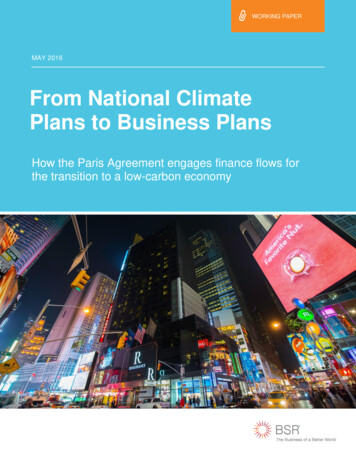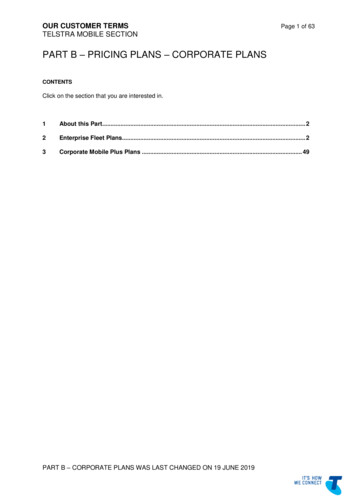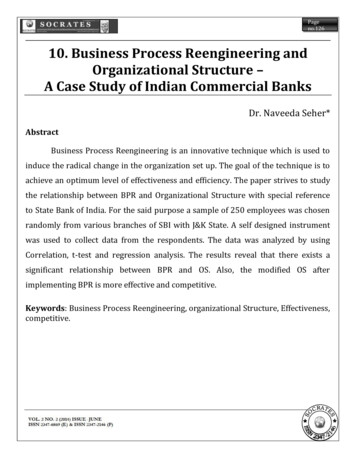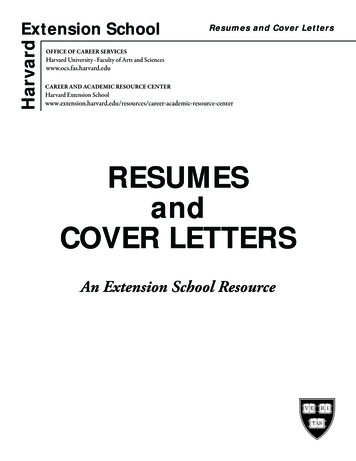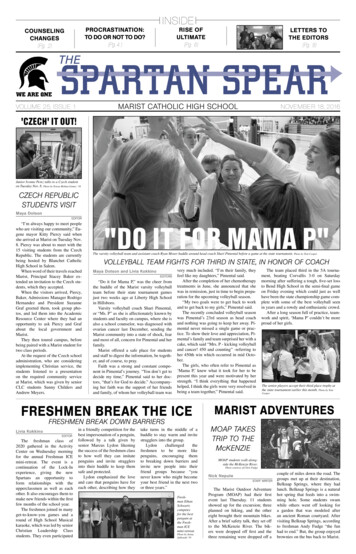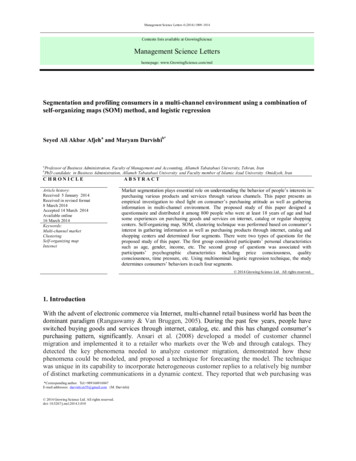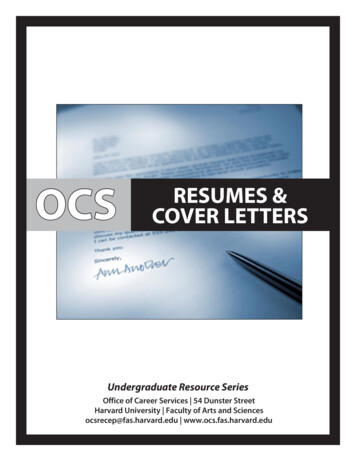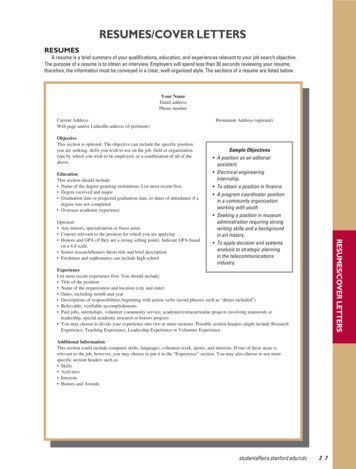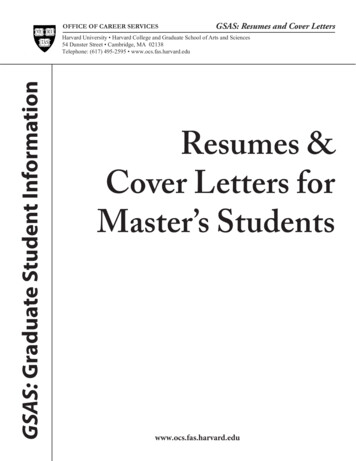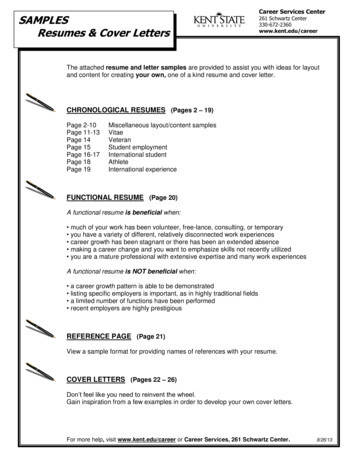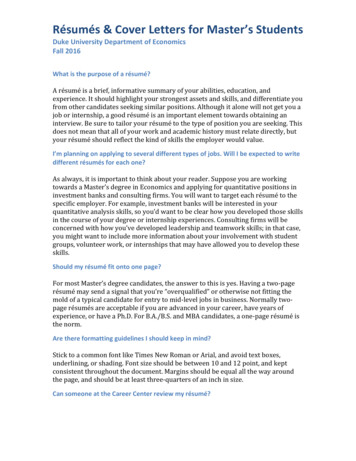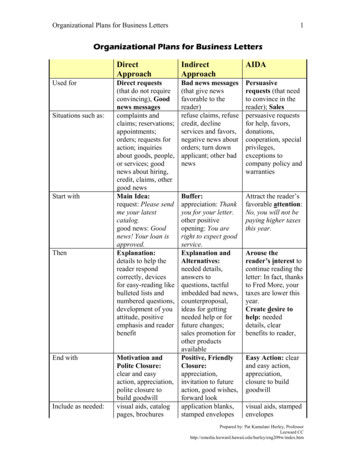
Transcription
Organizational Plans for Business Letters1Organizational Plans for Business LettersUsed forSituations such as:Start withThenEnd withInclude as needed:DirectApproachIndirectApproachAIDADirect requests(that do not requireconvincing), Goodnews messagescomplaints andclaims; reservations;appointments;orders; requests foraction; inquiriesabout goods, people,or services; goodnews about hiring,credit, claims, othergood newsMain Idea:request: Please sendme your latestcatalog.good news: Goodnews! Your loan isapproved.Explanation:details to help thereader respondcorrectly, devicesfor easy-reading likebulleted lists andnumbered questions,development of youattitude, positiveemphasis and readerbenefitBad news messages(that give newsfavorable to thereader)refuse claims, refusecredit, declineservices and favors,negative news aboutorders; turn downapplicant; other badnewsPersuasiverequests (that needto convince in thereader); Salespersuasive requestsfor help, favors,donations,cooperation, specialprivileges,exceptions tocompany policy andwarrantiesBuffer:appreciation: Thankyou for your letter.other positiveopening: You areright to expect goodservice.Explanation andAlternatives:needed details,answers toquestions, tactfulimbedded bad news,counterproposal,ideas for gettingneeded help or forfuture changes;sales promotion forother productsavailablePositive, FriendlyClosure:appreciation,invitation to futureaction, good wishes,forward lookapplication blanks,stamped envelopesAttract the reader’sfavorable attention:No, you will not bepaying higher taxesthis year.Motivation andPolite Closure:clear and easyaction, appreciation,polite closure tobuild goodwillvisual aids, catalogpages, brochuresArouse thereader’s interest tocontinue reading theletter: In fact, thanksto Fred More, yourtaxes are lower thisyear.Create desire tohelp: neededdetails, clearbenefits to reader,Easy Action: clearand easy action,appreciation,closure to buildgoodwillvisual aids, stampedenvelopesPrepared by: Pat Kamalani Hurley, ProfessorLeeward index.htm
Organizational Plans for Business Letters2Direct RequestsThe direct request message asks the reader to do something that s/he is inclined todo: placing an ordermaking business reservations and appointmentsrequesting action related to routine business proceduresmaking claims requests for adjustment (about damaged, faulty, wrong or lategoods)making complaints (about poor service, unfair billing, impolite letters)inquiring about products and servicesinquiring about persons (references by a person interested in an applicant.)Since we don’t need to convince the reader to fulfill our request, we use the directapproach:I.Main IdeaII.ExplanationIII.Motivation andPolite ClosureIntroduce your request, major statement or question (such as yourreason for writing to this person, purpose of adjustment, statement oforder or reservation)State reason(s) if desirable justifying the request (such as reasons forinterest in product or service, why you’re interested in the applicant,why you want a particular action done)Reason for writing to this particular reader (especially wheninquiring about a person/applicant)Details to help the reader respond to your request correctly (such ascost, size, color, quantity, catalog number, payment method, deposit,shipment, special instructions, all facts pertaining to order or claim)Devices for easy reading and easy answering (such as numberedquestions, bulleted lists, use of charts)Development of you attitude (such as emphasizingcompany’s/product’s/ service’s qualities or your faith in the readerinstead of anger, threats, sarcasm, or exaggerationClear action (what action you want the reader to take and when),easy action (enclosing reply envelope, phone number office hours orother helpful info), appreciation, polite closure to build goodwillGood news and neutral messagesGood news messages convey good news for the reader. These are messages thatwill be received favorably by our reader. Good news messages say “yes”:Prepared by: Pat Kamalani Hurley, ProfessorLeeward index.htm
Organizational Plans for Business Letters3Good News Messages, Cont. granting requests for claims adjustmentsapproving creditacknowledging ordersgranting favorsmaking announcementsresponding favorably to requests for action and informationwriting positive letters of recommendationsgiving favorable news about hiring or other applicationsconveying other good newsBecause we know our reader will be happy with the news we have to convey, we use thedirect approach:I.Main IdeaII.Explanation,which mayincludeIII.Positive,FriendlyClosurePositive opening telling the reader what s/he wants to hear first (creditgranted, shipment sent, favor accepted, request granted)Courteous comment, thinks for remittance/order, congratulationsVerification of information: description, costs, quantity, charges,dates, deliveryAll needed details (answer all questions, including 5 W’s, givecomplete instructions, stress reader benefits, positive emphasis,helpfulResale material, with reader benefit, when appropriate (emphasizewhat company can do for the reader, give reader choices)Educational material (explain product use, legal aspects,confidentiality, directions for filling out forms, instructions)For claims letters, start with a telephone call. If that doesn’t work,then begin keeping records of receipts, the dates and times of phonecalls, the names of people you speak to, and all letters. Base yourclaim on fact and avoid threats, laying blame or exaggeration. Explainwhat you think the problem is and say what you’d like done to besatisfied (refund? replacement? repair?) Have faith in the reader’sfairness – that once you’ve explained the problem, you’re reader try tosatisfy you and keep you as a customer.Sales promotion, if appropriate (give needed details on products andservices)Appreciation to reader; clear statement of action desired; easy action(offer of further help, enclosed forms or envelope); willingness to helpfurther; forward look to future use of goods and services, goodwishes, compliment or request; reader benefit and courtesyPrepared by: Pat Kamalani Hurley, ProfessorLeeward index.htm
Organizational Plans for Business Letters4Bad news MessagesBad news messages convey bad news for the reader. These are messages that will notbe received favorably by our reader. Bad news messages say “no”: conveying negative news about claims adjustmentsrefusing creditdeclining requests or favorsconveying bad news about requeststurning down an applicant for a job, scholarship, promotion, etc.requiring minimum deposits or ordersconveying news about price increasesconveying other negative newsBad news messages must be written carefully so as not to cause the reader to breakoff relations completely. Since we know that reader will be irritated, angry ordisappointed, we use the indirect approach:I.BufferII.Explanation/Analysis ofCircumstancesIII.Decision andAlternativesIV.Positive,Friendly ClosureDon’t begin with the bad news! Start positively (appreciation,agreement, assurance and understanding, good news, neutralcourtesy, sympathyNeeded details (general to specific), answer all questions, tactfuland logical statements of reasons, details about requirements, detailsabout what’s wrongPertinent and tactful favorable then unfavorable facts (record,duties, habit, deliveries, deadlines); company policy, legal aspects,procedures, emphasis on desired goalImbedded bad news (stated just once clearly, tactfully, conciselyand positively); helpful counterproposal and alternatives, ideas forgetting needed help, possible future changes; sales promotion andother products availableAppreciation, invitation to future action, easy action and motivation(enclosed reply forms and envelope), willingness to help further,good wishes, hope for improvement, forward lookPersuasive Request MessagesPersuasive requests are messages that ask the reader to do something that s/he isinclined NOT to do:Prepared by: Pat Kamalani Hurley, ProfessorLeeward index.htm
Organizational Plans for Business Letters5Persuasive Messages, Cont. request for favors and helprequest for donationsrequest for cooperation (on projects and goals)requests that require special privilege (such as for credit or adjustments notcovered by the warranty)requests that require the company to make an exception for you or change inpolicy or performancesales lettersSince the reader automatically wants to refuse our request, we need to convincehim/her of the benefits of doing what we’re asking. Therefore, the direct approach willnot be effective. Instead, use the AIDA formula: Attention, Interest, Desire, and ActionAIDA Formula for Routine Persuasive RequestsI.Attract the reader’s favorable attention in the very first sentence. Convince thereader right at the start that you have something useful or interesting to say. Make theopening statement brief and engaging without making extravagant claims.II.Arouse the reader’s interest so that s/he will continue to read the letter. This sectionexplains the relevance of your message to the reader. Continuing the theme you startedwith, paint a more detailed picture with words. Your goal is to get the reader to think,“This is an interesting idea; could it possibly solve my problems?”III.Create desire to help. These letters always emphasize how the reader will benefitfrom doing what we’re asking. In letters asking for donation, emphasize doing good forthe community, having his/her name connected with the writer or the event, or publicity.In letters asking for favors and help, emphasize how the request will help his/.herreputation or will help the writer’s good cause.IV.Make clear the action the reader needs to take. This section offers a good opportunityfor one last reminder of the main benefit the reader will realize from the action you want.Tell the reader what to do to help, such as supplying a name of a contact, a phonenumber, reply forms, stamped envelope. End with a statement of appreciation.SalesLettersNon-Routine Persuasive RequestsOpen by capturing the reader’s attention: pose a question, state a terrific offer,announce important newsEmphasize a central selling point. Appeal to the needs of the reader and showhow your product or service can help solve the reader’s problems. Introducethe price strategically and show how the item is worth its priceStimulate the reader to act and provide easy action (phone number, stampedenvelope). Express appreciation.Prepared by: Pat Kamalani Hurley, ProfessorLeeward index.htm
Organizational Plans for Business Letters6Persuasive Messages, Cont.Fundraising Remember that you’re not the only organization asking for a donation.Prove that your organization is worthy, that the donor’s money will affectLettersthe community positively.Begin by catching the reader’s attention with a story, question orquotation. Avoid starting with “Let me introduce ourselves. We.” Yourletter will look like everyone else’s.Motivate the reader to solve the problem by describing the specific peoplein need. Show that the problem can be solved – with your group’s help.Show in detail how your organization is helping. Prove private funds areneeded. Show what the money will go for, perhaps showing what specificitems cost.Show how your organization will “pay back” the donor: publicity (Yourname will be prominently displayed on a banner. in a program. for ourmany friends and family to see), having their name connected with yourorganization, doing good for the community.End with you phone number and say someone will call back within acertain time (1 – 2 weeks). Express appreciation.Goodwill MessagesGoodwill messages are special messages. Unlike good news message that say“yes’ to the reader related to business, goodwill messages are meant to build goodwill.These messages usually come as a pleasant surprise and are always appreciated.Finding the right words to express feelings is sometimes more difficult thanwriting ordinary messages. Yet a ready-made card does not have the same impact as apersonalized letter. Dr. Mary Ellen Guffey, best-selling author, recommends these 5 W’sof Goodwill Messages:1. Be selfless. Focus on the reader, not on the sender2. Be specific. Instead of vague statements (You did a good job), include specialdetails (Your strategy for approaching customers proved to be outstanding)3. Be sincere. Show your honest feelings with conversational, everyday language.4. Be spontaneous. Strive to make the message natural, fresh and direct. Avoidcanned phrases (If I may be of service, please do not hesitate.)5. Be short. Goodwill messages are fairly brief.Prepared by: Pat Kamalani Hurley, ProfessorLeeward index.htm
Organizational Plans for Business Letters7Goodwill Messages, Cont.Goodwill messages convey congratulations (personal and professional), showappreciation, extend sympathy and condolence, and show recognition and specialcontinuing nExtendingSympathyShowingRecognitionSend congratulatory messages for highlights in people’s personallives (weddings, births, graduations, success in non-businesscompetitions) or in their professional lives (new job, promotion,other business accomplishment)As appropriate, express your pride in the reader’s accomplishmentor state how the reader deserves the honor without being gushy.Cover three points in gift thank-you’s (1) identify the gift, (2) tellwhy you appreciate it, and (3) explain how you will use it.Be sincere in sending thanks for a favor or for hard work. Tellwhat the favor means to you. Avoid superlatives and gushiness.Maintain credibility with sincere, simple statements
getting needed help, possible future changes; sales promotion and other products available IV. Positive, Friendly Closure Appreciation, invitation to future action, easy action and motivation (enclosed reply forms and envelope), willingness to help further, good wishes, hope for improvement, forward look Persuasive Request MessagesFile Size: 228KBPage Count: 7
